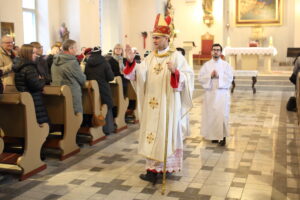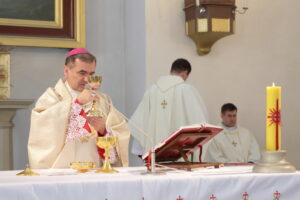After centuries of prohibition, the small Estonian Catholic community is rising from the ashes. On 26 September 2024, Pope Francis created the country’s first diocese. On 1 November 2024, Pope Francis addressed the Estonian Catholic Church on the occasion of the centenary of the creation of its apostolic administration, shortly after it was established as a diocese. The pontiff congratulated the Church for its “example of faith”, despite “decades of suffering, occupation and oppression”, and stated that “this admirable legacy of faith and charity will encourage the current generation of priests, religious and lay faithful.”
The new diocese is headed by Bishop Philippe Jourdan, apostolic administrator since 2005, who arrived from France in 1996 and has acquired Estonian citizenship. In an interview for Aid to the Church in Need (ACN), Bishop Jourdan presents the situation of Catholics in the country.
ACN: What is the religious situation in Estonia?
Bishop Jourdan: Estonia remains one of the most secularized countries in Europe: about 25% of the population are believers and the rest declare themselves non-believers, although, in reality, many people believe without really knowing what they think. Curiously, while in the rest of Europe secularization is advancing more and more, these percentages have remained fairly stable here in the last 25 years.
Why are there so few Catholics in Estonia?
The Catholic Church disappeared from Estonia in the 16th century, coinciding with the Lutheran Reformation. For two and a half centuries it was banned and did not re-emerge until the beginning of the 19th century. But then the country suffered 50 years of Soviet rule. Estonia therefore has a unique history as a hinge between two worlds that rejected Catholicism.

NOTE: Please use with credit to: Diocese of Tallinn.
Is the situation changing?
Yes, the Catholic community is constantly growing. In 1970, we were less than a dozen, and now we are between 7,000 and 10,000. We have always had requests for baptisms, but for the last two to three years the number of catechumens has become increasingly younger. There is no doubt that since Covid and the war in Ukraine, young people today are asking more existential questions and some have also realized that the post-Soviet ideal, which is very consumerist (understandable after a period of great poverty), does not fully satisfy them.
Who makes up the Catholic community in Estonia today?
Half of the population are “ethnic” Estonians, converts or children of converts, while the other half are Russian-speaking (30% of the Estonian population today is Russian-speaking), partly from Belarus or Ukraine, and of Latin or Eastern rite. In addition, for the last 4-5 years we have had some immigrants from all over the world.

NOTE: Please use with credit to: Diocese of Tallinn.
Why was this first diocese established now?
One hundred years ago, in 1924, Pope Pius XI created an apostolic administration. This was a temporary situation, until the Church grew and became structured. Obviously, the 50 years of Soviet rule slowed down this growth, but now we can finally provide the Church in this country with an official structure. Today we have a diocese with ten provinces (8 of Latin rite and 2 of Eastern rite) and 15 priests of different nationalities… It is the culmination of a long journey that has made everyone very happy.
How has the Lutheran Church received this news?
With great joy! The creation of this diocese has been very well received and widely reported by the local press. Ecumenism has made great progress in recent years, as Catholics and Protestants have managed to overcome centuries of division. In addition, we share the same concerns about social issues, the war in Ukraine…
What is your feeling after taking office as bishop of this new diocese?
Obviously, my wish is that we continue to grow, mature and organize ourselves. But above all, we must preserve our greatest strength, which is prayer. Sometimes we feel a little helpless, but the Lord does not leave us alone: Divine Providence has always accompanied us. Therefore, we must continue our mission, tirelessly, to promote vocations and be bearers of hope for all those around us.










